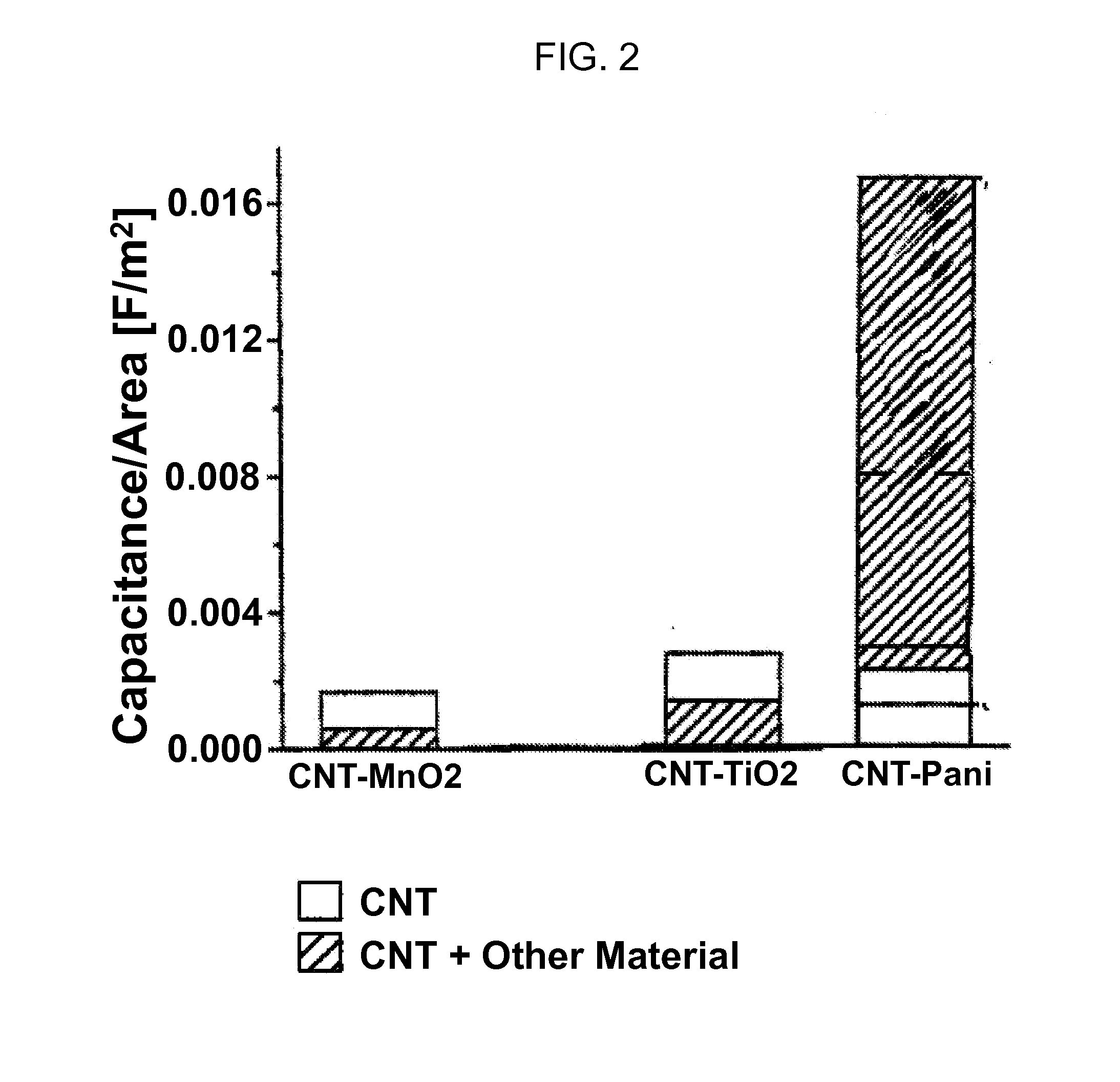Charge storage device architecture for increasing energy and power density
a technology of energy storage and power density, applied in the direction of fuel and primary cells, cell components, transportation and packaging, etc., can solve the problems of inability to show exciting improvement in energy or power performance, limited energy density by its effective double-layer area, and high scanning rate capacitan
- Summary
- Abstract
- Description
- Claims
- Application Information
AI Technical Summary
Benefits of technology
Problems solved by technology
Method used
Image
Examples
example 1
A Carbon Nanotube Film as DLS Material
[0081]In certain embodiments of the present invention, a charge storage device may comprise a CNT film as a DLS material.
[0082]SWNTs were dissolved in pure water (1-2 mg / ml) with the aid of a tip sonicator. Using an air brush pistol the stable suspension was sprayed onto overhead transparencies (polyethylene-terephthalate, PET) which were placed on a heating plate at ˜100° C. During spraying, the water evaporates and the CNTs form an entangled random network on the PET. Afterwards the CNT coated PET substrates were used as the carbonaceous nanostructured network (DLS material) without any further treatment.
[0083]A polymer electrolyte was prepared by mixing polyvinyl alcohol (PVA) with water (1 g PVA / 10 ml H2O) and subsequent heating under stirring to ˜90° C. until the solution becomes clear. After cooling down, conc. phosphoric acid was added (0.8 g) and the viscose solution was stirred thoroughly. Finally, the clear solution can be cast into a ...
example 2
Carbonaceous Networks Together with ECS Materials
[0084]Use of a DLS material in combination with an ECS material in a charge storage device electrode may take advantage of both the high conductivity of the CNT networks and the high specific capacitance of the coating potentially increasing the capacitance of CNT networks. The ECS material was sprayed on top of the CNT networks. In such a multiple network the CNT network can act not only as a DLS material, but also as a current collector (e.g., where the additional ECS material coating is the active material). This multilayer structure is fundamentally different from composites where all materials (e.g., DLS material and ECS material) are mixed together, potentially interrupting the current conducting paths within the CNT network. The performance of these multiple networks is evidenced in FIGS. 1 and 2 in terms of internal resistance and capacitance / area, respectively.
[0085]When using inorganic coatings as an ECS material, here MnO2 ...
example 3
Electrode Device with CNT and Carbon / Polyaniline (PANI) Electrodes
[0087]In an experimental embodiment of the present invention, a three-layer structure, with CNTs as one electrode and a two-layer CNT / polyaniline (PANI) structure as a second electrode, was fabricated and compared with a symmetric DLS architecture with two electrodes formed from CNTs.
[0088]A SWNT suspension (1.0 mg CNTs / ml in deionized water) was sprayed onto polyethyleneterephthalate (PET) which was heated at temperature about 120° C. The spayed film was ready to use as a working electrode in the PANI electrodeposition; its resistance was around 1000 as measured by a two-probe multi-meter. The thickness of the SWNT film was roughly 1 μm. The electrodeposition of PANI was carried out using a three-electrode electrochemical cell with an Ag / AgCl reference electrode and a platinum sheet as the auxiliary electrode. The PANI film was electrodeposited using cyclic sweep with a GillAC device (AutoAC, ACM Instruments, UK) in ...
PUM
 Login to View More
Login to View More Abstract
Description
Claims
Application Information
 Login to View More
Login to View More - R&D
- Intellectual Property
- Life Sciences
- Materials
- Tech Scout
- Unparalleled Data Quality
- Higher Quality Content
- 60% Fewer Hallucinations
Browse by: Latest US Patents, China's latest patents, Technical Efficacy Thesaurus, Application Domain, Technology Topic, Popular Technical Reports.
© 2025 PatSnap. All rights reserved.Legal|Privacy policy|Modern Slavery Act Transparency Statement|Sitemap|About US| Contact US: help@patsnap.com



